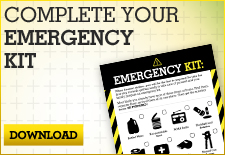
Disasters can happen… at any time. Be prepared to take action before, during and after.
Foodborne illness (sometime called food borne disease or food poisoning) is any illness resulting from the consumption of contaminated food, pathogenic bacteria, viruses, or parasites that contaminate food. Each year, 48 million people (1 in 6 Americans) in the U.S. get sick from contaminated food. Food can become contaminated through a variety of mechanisms and may occur at any stage in the process from food production to consumption.
- Upset stomach
- Abdominal cramps
- Nausea and vomiting
- Diarrhea
- Fever
- Dehydration
- Inadequate hand washing
- Cross‐contamination
- Storage and cooking temperatures
- Contamination of food by waste
You can find detailed information regarding foodborne illnesses by contacting your local public health department or by visiting the Center for Disease Control website.
Before
At home, preventing foodborne illness mainly consists of good food safety practices. Many forms of food poisoning can be prevented, even if food is contaminated, by cooking it sufficiently, and either eating it quickly or refrigerating it effectively. Make sure you wash your hands thoroughly with soap and warm water before preparing food. If you are sick or have been sick in the past 3 days, do not prepare food for others.
2 – Complete the Emergency Contacts Card and place one in your Emergency Kit.
3 – Prepare an Emergency Kit. The Emergency Kit should be easily accessible should you and your family be forced to shelter in place (stay at home) for a period of time.
- Keep clean
- Separate raw and cooked foods
- Cook thoroughly
- Keep food at safe temperatures
- Use safe water and raw materials
cause illnesses. A meat thermometer should be used to ensure foods are cooked to the appropriate
internal temperature:
– 145 degrees for roasts, steaks, and chops of beef, veal, pork, and lamb, followed by 3 minutes of rest time after the meat is removed from the heat source
– 160 degrees for ground beef, veal, pork, and lamb
– 165 degrees for poultry
- Cold foods should be kept cold and hot foods should be kept hot.
- Fruits and vegetables should be washed under running water just before eating, cutting, or cooking. A produce brush can be used under running water to clean fruits and vegetables with firm skin.
- Raw meat, poultry, seafood, and their juices should be kept away from other foods.
- People should wash their hands for at least 20 seconds with warm, soapy water before and after handling raw meat, poultry, fish, shellfish, produce, or eggs. People should also wash their hands after using the bathroom, changing diapers, or touching animals before handling any food.
- Utensils and surfaces should be washed with hot, soapy water before and after they are used to prepare food. Diluted bleach—1 teaspoon of bleach to 1 quart of hot water—can also be used to sanitize utensils and surfaces.
The only treatment needed for most foodborne illnesses is replacing lost fluids and electrolytes to prevent dehydration. Remember that infants and children are likely to become dehydrated more quickly from diarrhea and vomiting because of their smaller body size. Older adults and adults with weak immune systems should also drink oral rehydration solutions to prevent dehydration.
Over‐the‐counter medications may help stop diarrhea in adults. However, people with bloody diarrhea—a sign of bacterial or parasitic infection—should not use these medications. If diarrhea is caused by bacteria or parasites, over‐the‐counter medications may prolong the problem. Medications to treat diarrhea in adults can be dangerous for infants and children and should only be given with a health care provider’s guidance.
- Drink plenty of liquids such as fruit juices, sports drinks, caffeine‐free soft drinks, and broths to replace fluids and electrolytes.
- Sip small amounts of clear liquids or suck on ice chips if vomiting is a problem.
- Gradually reintroduce food, starting with bland, easy‐to‐digest foods such as rice, potatoes, toast or bread, cereal, lean meat, applesauce, and bananas.
- Avoid fatty foods, sugary foods, dairy products, caffeine, and alcohol until recovery is complete.
- Provide oral rehydration solutions using water and drinks with electrolytes.
- Give your child food as soon as they are hungry.
- Provide infants with breast milk or full strength formula, as usual, along with oral rehydration solutions.



